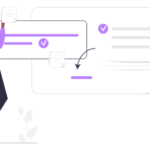Customer support logs are an endless source of data for building insightful customer journey maps. However, we’ve discovered that it’s not as popular as it could be. Based on the research weconducted, only around 30% of people actually use support requests from customers as a source of data for their CJMs. Comparing with the most popular data sources (customer interviews are conducted by 71%) and data and analytics (69%) it’s not that impressive. So what's the reason? There's a number of them:
- A company doesn’t have an organized support process in place yet. Customer feedback they receive is rather sporadic.
- The company has a tonne of support requests which is hard to process or even look through.
- Support requests are considered subjective and not quantitative.
- Support requests are considered reactive and no one is willing to wait till customer reports an issue or shares some feedback.
We see this as a lost opportunity. Customer support logs is a great source of inspiration and here why.
Contents
Why use support logs for journey mapping?
Take interviews with customers. Conducting a series of interviews requires significant time and effort.
First, you need to come up with interview plan and approve it with the team and all the stakeholders. Then you need to prepare questions, figure out how to motivate potential participants + make sure they are representative. And that's half the fun as now you need to schedule interviews which often is the trickiest part because people you want to reach the most are often the busiest ones. Oh, and you also risk having little to no insights at all as participants might be not in a good mood, not native speakers, or simply having troubles expressing their thoughts.
Now, don’t get us wrong - we love interviews. No other technique gives such diversity of insights and inspiration. What we are saying is interviews need a lot of time, careful planning, and dedication. And while you're at it, getting ready for interviewing your customers, you can benefit from the data at hand. Yes - from your customer support logs.

Besides, unlike talking interviewing people in a sterile room sipping coffee, issues and feedback people report to your support team are given in a context. And it's priceless: they don’t speculate on the things they might use (although sometimes you’d like to hear those speculations, too), they complain about issues they are struggling with here and now.
Organized in a certain way, support can provide both quantitative and qualitative information. You can hardly cover the same amount of people during an interview. And the best part is you can use support communication findings as a basis for in-depth research.
How to integrate support logs into journey maps?
So, what’s the secret of using data collected by the support team for building customer journey maps?
First of all, if you don’t have any support tickets tracking system in place yet, you can still benefit from other types of feedback you already have, for instance, Yelp reviews. They can be analyzed pretty much the same way as your support tickets.
The key step is classifying all existing feedback you already have to identify patterns. You can use tags - we recommend adding area tag (what product or service area feedback belongs to, e.g. “onboarding” or “check-in”) and a keyword to identify the issue in brief (e.g. “Jira integration” or “car drop-off locations”). Areas help to locate the particular place for feedback on the customer journey. They often reflect stages or substages of the customer journey.
Keywords help to perform quantitative analysis and evaluate how common the issue is, whether it’s an opinion of one particular customer (though it doesn’t mean you shouldn’t listen and consider it!) or a barrier everyone has to deal with when interacting with your service. Add the total number of times someone reported particular subject to get the prioritized list of them.
It will be a cumbersome exercise to perform if you already gathered lots of feedback but perform this once, make internal convention with the support team to add tags each time a new request comes in and things will get much simpler in future.
It’s up to you where and how to store these data. It can be a simple spreadsheet as long as it helps you to view and filter the findings. We at UXPressia are big fans of Intercom and Airtable and we use these services for storing and processing user feedback.
When mapping the customer journey, focus on each stage and look through the feedback marked for a particular area. Order based on keywords frequency and don’t hesitate to quote your customers here. Based on particular feedback nature, it might be appropriate to add it either to Problems/Barriers (something that prevents customers from going to the next stage or anyhow frustrates them) or Ideas (feature requests and any suggestions about how the experience might be improved). Don’t forget the total number of such requests so the team will get a feeling of how common it is:
Last but not least: be proactive. Don’t wait till customers come to you and tell what they like or dislike about your service. Encourage them to share their experience at the moments where this is crucially important for your analysis.
For example, a user purchases a subscription at your service - congrats, it’s a great thing, but do you know why this happened? Or a user is leaving (removing the account, canceling subscription) - is it just a change of job position, or completed project, or a missing feature in your product? You need to know what works and what doesn’t in order to meet your business goals. Some people will respond in 1-2 words - and that’s ok, you don’t have to bombard them with a tonne of messages if they don’t look like talking much about their experience. The others will share some details: the goal they had in mind, behavioral traits, the context (environment, other tools in use, other people involved) etc. and knowing your customers is a must for building an outstanding journey.
And don't forget to map it all our in UXPressia Customer Journey Mapping Online tool where you can quickly create and export an awesome-looking customer journey map or a customer persona!






